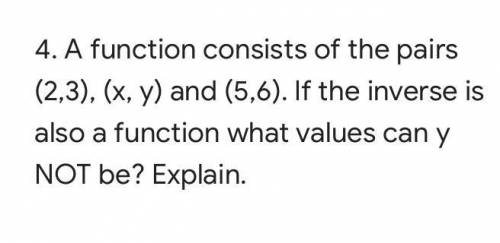
Mathematics, 10.11.2020 01:50 melanyrivera776
4. A function consists of the pairs (2,3), (x, y) and (5,6). If the inverse is also a function what values can y NOT be? Explain.


Answers: 3


Another question on Mathematics

Mathematics, 21.06.2019 17:10
Consider the functions below. function 1 function 2 function 3 select the statement which is true about the functions over the interval [1, 2] a b function 3 has the highest average rate of change function 2 and function 3 have the same average rate of change. function and function 3 have the same average rate of change function 2 has the lowest average rate of change d.
Answers: 3


Mathematics, 22.06.2019 01:10
Simplify each expression. use positive exponents. show work . (x –2 y –4 x 3 ) –2
Answers: 2

Mathematics, 22.06.2019 01:30
Drag the tiles to the correct boxes to complete the pairs. match the exponential functions with their horizontal asymptotes and y-intercepts. f(x) = 7x − 4 f(x) = 3x+2 + 4 f(x) = 9x+1 − 4 f(x) = 2x + 4 horizontal asymptote and y-intercept exponential function horizontal asymptote: y = 4 y-intercept: (0, 5) arrowboth horizontal asymptote: y = -4 y-intercept: (0, 5) arrowboth horizontal asymptote: y = -4 y-intercept: (0, -3) arrowboth horizontal asymptote: y = 4 y-intercept: (0, 13) arrowboth
Answers: 1
You know the right answer?
4. A function consists of the pairs (2,3), (x, y) and (5,6). If the inverse is also a function what...
Questions

English, 04.12.2020 04:40



English, 04.12.2020 04:40



Social Studies, 04.12.2020 04:40


Mathematics, 04.12.2020 04:40

Mathematics, 04.12.2020 04:40






Health, 04.12.2020 04:40




 cannot be 3 or 6 in the inverse function for all
cannot be 3 or 6 in the inverse function for all  distinct from 2 and 5.
distinct from 2 and 5.  . Otherwise, the inverse could not be a function when
. Otherwise, the inverse could not be a function when  .
.

